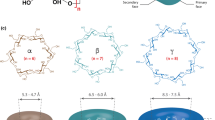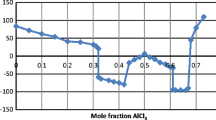Abstract
The state of the art of inclusion complex formation between cyclodextrins and ionic liquids is reported. Mechanisms, stoichiometries, and binding constants are summarized and classified by anion. We investigated the supramolecular interactions between the β-cyclodextrin cavity and six ionic liquids based on 1-dodecyl-3-methylimidazolium by affinity capillary electrophoresis and compared the results with those obtained by isothermal titration calorimetry. We show that the presence of basic or acidic buffers leads to a metathesis reaction, underlining the limitation of the affinity capillary electrophoresis technique.



Similar content being viewed by others
References
D’Souza VT, Lipkowitz KB. Cyclodextrins: introduction. Chem Rev. 1998;98:1741–2.
Kenneth AC. Binding constants: the measurement of molecular complex stability. 1st ed. Oxford: Wiley-Interscience; 1987.
Huddleston JG, Visser AE, Reichert WM, Willauer HD, Broker GA, Rogers RD. Characterization and comparison of hydrophilic and hydrophobic room temperature ionic liquids incorporating the imidazolium cation. Green Chem. 2001;3:156–64.
Hallett JP, Welton T. Room-temperature ionic liquids: solvents for synthesis and catalysis 2. Chem Rev. 2011;111:3508–76.
Anderson JL, Ding J, Welton T, Amstrong DW. Characterizing ionic liquids on the basis of multiple solvation interactions. J Am Chem Soc. 2002;124:14247–54.
Rogalski M, Modaressi A, Magri P, et al. Physico-chemical properties and phase behavior of the ionic liquid-β-cyclodextrin complexes. Int J Mol Sci. 2013;14:16638–55.
Mahlambi MM, Malefetse TJ, Mamba BB, Krause RWM. Polymerization of cyclodextrin-ionic liquid complexes for the removal of organic and inorganic contaminants from water. In: Korkorin A, editor. Ionic liquids: applications and perspectives. Rijeka: InTech; 2011. p. 115–51.
Duri S, Tran CD. Supramolecular composite materials from cellulose, chitosan, and cyclodextrin: facile preparation and their selective inclusion complex formation with endocrine disruptors. Langmuir. 2013;29:5037–49.
Raoov M, Mohamad S, Abas MR. Synthesis and characterization of β-cyclodextrin functionalized ionic liquid polymer as a macroporous material for the removal of phenols and arsenic (V). Int J Mol Sci. 2014;15:100–19.
Amajjahe S, Munteanu M, Ritter H. Switching the solubility of PMMA bearing attached cyclodextrin-moieties by supramolecular interactions with ionic liquids. Macromol Rapid Commun. 2009;30:904–8.
Leclercq L, Lacour M, Sanon SH, Schmitzer AR. Thermoregulated microemulsions by cyclodextrin sequestration: a new approach to efficient catalyst recovery. Chem Eur J. 2009;15:6327–31.
Li S, Xing P, Hou Y, Yang J, Yang X, Hao BA. Formation of a sheet-like hydrogel from vesicles via precipitates based on an ionic liquid-based surfactant and β-cyclodextrin. J Mol Liq. 2013;188:74–80.
Zhang J, Shen X. Temperature-induced reversible transition between vesicle and supramolecular hydrogel in the aqueous ionic liquid-β-cyclodextrin system. J Phys Chem B. 2013;117:1451–7.
Jiangna G, Chao Y, Mingyu G, Lei W, Feng Y. Flexible and voltage-switchable polymer velcro constructed using host-guest recognition between poly(ionic liquid) strips. Chem Sci. 2014;5:3261–6.
Zhou Z, Li X, Chen X, Hao X. Synthesis of ionic liquids functionalized β-cyclodextrin-bonded chiral stationary phases and their applications in high-performance liquid chromatography. Anal Chim Acta. 2010;678:208–14.
Huang K, Zhang X, Amstrong DW. Ionic cyclodextrins in ionic liquid matrices as chiral stationary phases for gas chromatography. J Chromatogr A. 2010;1217:5261–73.
Stalcup AM, Cabovska B. Ionic liquids in chromatography and capillary electrophoresis. J Liq Chromatogr. 2004;27:1443–59.
Mendes A, Branco LC, Morais C, Simplicio AL. Electroosmotic flow modulation in capillary electrophoresis by organic cations from ionic liquids. Electrophoresis. 2012;33:1182–90.
Tran CD, De Paoli Lacerda S. Near-infrared spectroscopic investigation of inclusion complex formation of cyclodextrins in room-temperature ionic liquid. J Incl Phenom Macrocycl Chem. 2002;44:185–90.
Gao YA, Li ZH, Du JM, et al. Preparation and characterization of inclusion complexes of β-cyclodextrin with ionic liquid. Chem Eur J. 2005;11:5875–80.
He Y, Shen X. Interaction between β-cyclodextrin and ionic liquids in aqueous solutions investigated by a competitive method using a substituted 3H-indole probe. J Photochem Photobiol A. 2008;197:253–9.
Rak J, Ondo D, Tkadlecova M, Dohnal V. On the interaction of ionic liquid 1-butyl-3-methylimidazolium hexafluorophosphate with β-cyclodextrin in aqueous solutions. Z Phys Chem. 2010;224:893–906.
Zhang J, Shen X. Multiple equilibria interaction pattern between the ionic liquids CnmimPF6 and β-cyclodextrin in aqueous solutions. J Phys Chem B. 2011;115:11852–61.
Li HG, Zhang Q, Liu M, Liu J, Sun DZ. Studies on interaction of ionic liquids with cyclodextrins in aqueous solution. Indian J Chem. 2010;49A:752–6.
Roy MN, Roy MC, Roy K. Investigation of an inclusion complex formed by ionic liquid and β-cyclodextrin through hydrophilic and hydrophobic interactions. RSC Adv. 2015;5:56717–23.
Amajjahe S, Choi S, Munteanu M, Ritter H. Pseudopolyanions based on poly(NIPAAM-co-β-cyclodextrin methacrylate) and ionic liquids. Angew Chem Int Ed. 2008;47:3435–7.
Hodyna D, Bardeau JF, Metelytsia L, et al. Efficient antimicrobial activity and reduced toxicity of 1-dodecyl-3-methylimidazolium tetrafluoroborate ionic liquid/β-cyclodextrin complex. Chem Eng J. 2016;284:1136–45.
Gao Y, Zhao X, Dong B, Zheng L, Li N, Zhang S. Inclusion complexes of β-cyclodextrin with ionic liquid surfactants. J Phys Chem B. 2006;110:8576–81.
Li N, Liu J, Zhao X, et al. Complex formation of ionic liquid surfactant and β-cyclodextrin. Colloids Surf A. 2007;292:196–201.
He Y, Chen Q, Xu C, Zhang J, Shen X. Interaction between ionic liquids and β-cyclodextrin: a discussion of association pattern. J Phys Chem B. 2009;113:231–8.
Zhang J, Shi J, Shen X. Further understanding of the multiple equilibria interaction pattern between ionic liquid and β-cyclodextrin. J Incl Phenom Macrocycl Chem. 2014;79:319–27.
Semino R, Rodríguez J. Molecular dynamics study of ionic liquids complexation within β-cyclodextrins. J Phys Chem B. 2015;119:4865–72.
Funasaki N, Ishikawa S, Neya S. 1:1 and 1:2 complexes between long-chain surfactant and α-cyclodextrin studied by NMR. J Phys Chem B. 2004;108:9593–8.
Ondo D, Tkadlecova M, Dohnal V, et al. Interaction of ionic liquids ions with natural cyclodextrins. J Phys Chem B. 2011;115:10285–97.
Hayes R, Warr GG, Atkin R. Structure and nanostructure in ionic liquids. Chem Rev. 2015;115:6357–426.
Lungwitz R, Spange S. A hydrogen bond accepting (HBA) scale for anions, including room temperature ionic liquids. New J Chem. 2008;32:392–4.
Schou C, Heegaard NH. Recent applications of affinity interactions in capillary electrophoresis. Electrophoresis. 2006;27:44–59.
Qi S, Cui S, Chen X, Hu Z. Rapid and sensitive determination of anthraquinones in Chinese herb using 1-butyl-3-methylimidazolium-based ionic liquid with β-cyclodextrin as modifier in capillary zone electrophoresis. J Chromatogr A. 2004;1059:191–8.
Aupoix A, Pegot B, Vo-Thanh G. Synthesis of imidazolium and pyridinium-based ionic liquids and application of 1-alkyl-3-methylimidazolium salts as pre-catalysts for the benzoin condensation using solvent-free and microwave activation. Tetrahedron. 2010;66:1352–6.
Wang M, Pan X, Xia S, Zhang C, Li W, Dai S. Regulating mesogenic properties of ionic liquid crystals by preparing binary or multi-component systems. J Mater Chem. 2012;22:2299–305.
Rodriguez-Palmeiro I, Rodriguez-Escontrela I, Rodriguez O, Arce A, Soto A. Characterization and interfacial properties of the surfactant ionic liquid 1-dodecyl-3-methyl imidazolium acetate for enhanced oil recovery. RSC Adv. 2015;5:37392–8.
Liu Y, Shamsi SA. Combined use of chiral ionic liquid surfactants and neutral cyclodextrins: evaluation of ionic liquid head groups for enantioseparation of neutral compounds in capillary electrophoresis. J Chromatogr A. 2014;1360:296–304.
François Y, Varenne A, Sirieix-Plenet J, Gareil P. Determination of aqueous inclusion complexation constants and stoichiometry of alkyl(methyl)-methylimidazolium-based ionic liquid cations and neutral cyclodextrins by affinity capillary electrophoresis. J Sep Sci. 2007;30:751–60.
Bertaut E, Landy D. Improving ITC studies of cyclodextrin inclusion compounds by global analysis of conventional and non-conventional experiments. Beilstein J Org Chem. 2014;10:2630–41.
Connors KA. Measurement of cyclodextrin complex stability constants. Compr Supramol Chem. 1996;3:205–41.
Tanaka Y, Terabe S. Estimation of binding constants by capillary electrophoresis. J Chromatogr B. 2002;768:81–92.
Parker KM, Stalcup AM. Affinity capillary electrophoresis and isothermal titration calorimetry for the determination of fatty acid binding with beta-cyclodextrin. J Chromatogr A. 2008;1204:171–82.
Danel C, Duval C, Azaroual N, et al. Complexation of triptolide and its succinate derivative with cyclodextrins: affinity capillary electrophoresis, isothermal titration calorimetry and 1H NMR studies. J Chromatogr A. 2011;1218:8708–14.
Favrelle A, Gouhier G, Guillen F, et al. Structure-binding effects: comparative binding of 2-anilino-6-naphthalenesulfonate by a series of alkyl- and hydroxyalkyl-substituted β-cyclodextrins. J Phys Chem B. 2015;119:12921–30.
Lynen F, Borremans F, Sandra P. Practical evaluation of the influence of excessive sample concentration on the estimation of dissociation constants with affinity capillary electrophoresis. Electrophoresis. 2001;22:1974–8.
Le Saux T, Varenne A, Gareil P. Peak shape modeling by Haarhoff-Van der Linde function for the determination of correct migration times: a new insight into affinity capillary electrophoresis. Electrophoresis. 2005;26:3094–104.
Steinbock B, Vichaikul PP, Steinbock O. Nonlinear analysis of dynamic binding in affinity capillary electrophoresis demonstrated for inclusion complexes of β-cyclodextrin. J Chromatogr A. 2001–2002;943:139–46.
Acknowledgments
The authors thank Claudette Martin from Rouen University for the analysis of the ionic liquids.
Author information
Authors and Affiliations
Corresponding author
Ethics declarations
Conflict of interest
The authors declare that they have no conflict of interest.
Electronic supplementary material
Below is the link to the electronic supplementary material.
ESM 1
(PDF 13.6 KB)
Rights and permissions
About this article
Cite this article
Mofaddel, N., Fourmentin, S., Guillen, F. et al. Ionic liquids and cyclodextrin inclusion complexes: limitation of the affinity capillary electrophoresis technique. Anal Bioanal Chem 408, 8211–8220 (2016). https://doi.org/10.1007/s00216-016-9931-z
Received:
Revised:
Accepted:
Published:
Issue Date:
DOI: https://doi.org/10.1007/s00216-016-9931-z




